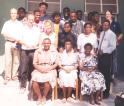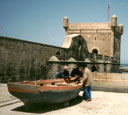130 photos.
 Joanitha and Joachim with Michael Hodd
Joanitha and Joachim with Michael HoddWindsor, UK, 2008
Michael Hodd was an economics professor at the University of Westminster, and the vice-chancellor of the University of Bukoba from 1999-2000.
 MV Victoria
MV VictoriaBukoba, Tanzania, 2003
This ferry goes to and from Mwanza three times a week. A similar ferry, the MV Bukoba, sank in an accident near Mwanza in 1996, and hundreds of passengers were drowned.
 the Vogl family at Christmas
the Vogl family at ChristmasSouth Bend, Indiana, 1999
Front row: Tom, Mary, Connor, Colette, Emmanuel, Greg. Back row: Mohammed, Joe, Don, Becky, Paul
 Greg, Mary and Emmanuel inner-tubing
Greg, Mary and Emmanuel inner-tubingSouth Bend, Indiana, 1999
Emmanuel had his first experience with snow in Indiana. He seemed not to mind the cold.
 Greg and Emmanuel Edomwande
Greg and Emmanuel EdomwandeSouth Bend, Indiana, 1999
Emmanuel and I taught at Ponhofi Senior Secondary School in Namibia for three years and shared a teacher hostel for a year. Emmanuel came to the US in 1999 and visited me and my family for Christmas. He recently completed his PhD in entomology and is living in Texas.
 Joanitha in academic gown
Joanitha in academic gownBukoba, Tanzania, 1999
studio portrait. University of Bukoba students were issued academic gowns when the university opened.
 Joanitha and friends carrying buckets
Joanitha and friends carrying bucketsBukoba, Tanzania, 1998
Only a small minority of African families get their water from a faucet in their homes. Many African women and girls must carry buckets of water on their heads for long distances so that their families can drink water, cook and wash clothes.
 Joanitha's shop
Joanitha's shopBukoba, Tanzania, 1998
After Sumve, Joanitha tried to start a shop, but it never really took off.
 the Vogl family at Christmas dinner
the Vogl family at Christmas dinnerSouth Bend, Indiana, 1997
Clockwise from upper left: Mary, Mohammed, Jim, Don, Colette, Paul, Suzy, Tom, Gertrude, Dawn,
 Joanitha near a tree planted by President Moi
Joanitha near a tree planted by President MoiKisumu, Kenya, 1997
Joanitha's school went on a sporting trip to Kenya and stopped by this monument to Kenya's long-time president. Many things were named after Moi, who held onto power for more than 20 years.
 Joanitha acting as a ghost
Joanitha acting as a ghostMwanza, Tanzania, 1997
Joanitha enjoyed drama and acting. Some students were afraid of her for some time after this performance.
 teacher-student basketball game, Ponhofi Senior Secondary School
teacher-student basketball game, Ponhofi Senior Secondary SchoolOhangwena, Namibia, 1997
This was my field of dreams. After three years of playing basketball on the unsurfaced, dusty netball court, with no nets or backboards and tiny rims, we finally found funding for a real basketball court. Playing in the teacher-student game at the end of the year was a dream come true. The girls picked up the game with amazing speed, probably because they could transfer the skills they knew from netball, a similar sport. The court was an expensive development project and hastened the inevitable Americanisation of the world, but it would be nice if every school in the North could have one. On the right is an enormous omukwiyu (wild fig) tree, good for shade and a popular hangout for kids and goats.
 staff, Ponhofi Senior Secondary School
staff, Ponhofi Senior Secondary SchoolOhangwena, Namibia, 1997
Greg Vogl (me), physics and computer teacher, USA, Monika Katanga, secretary, Namibia, Tuyeni Ndaikile, Kwanyama teacher, Namibia, Martha (Katiti) Nhinda, Kwanyama teacher, Namibia, Irene Carolissen, English teacher, Namibia, Saima Amunyela, Kwanyama teacher, Namibia, Lydia (Ivawa) Munghadi, biology teacher, Namibia, Liam Garvey, mathematics teacher, Australia, Julie Murphy, accounting teacher, Scotland, Philip Shimhanda, natural economy teacher, Namibia, Emmanuel Edomwande (seated), biology teacher, Nigeria, Eric Kemanya, English teacher, Namibia, Mark Fleming, mathematics teacher, Scotland, Mary (Maria) Nashandi, business studies teacher, Namibia, Peter Maswahu, agriculture teacher, Namibia, Lucky (Nhlanhla) Lupahla, mathematics teacher, Zimbabwe, Michael Kavungo, Vice-Principal and English teacher, Namibia, Håkon Hermanstrand, English teacher, Norway
 House 19, Ponhofi School
House 19, Ponhofi SchoolOhangwena, Namibia, 1997
I lived in this house with a Nigerian entomologist. There were plenty of insects for him to study.
 House 16, Ponhofi School
House 16, Ponhofi SchoolOhangwena, Namibia, 1997
I stayed in this house in late 1995 with Liam Garvey from Australia.
 Red, white and blue tin house
Red, white and blue tin houseOhangwena, Namibia, 1997
I passed this abandoned shack in the middle of an empty lot whenever going into town. I took this photo the morning I left Ohangwena. Elago Elago writes: As it's painted in DTA colours, I suspect it's an abandoned DTA cardboard type pre-fabricated office. The DTA had quite many of those (and mobile ones) in the 4 northern regions and after losing quite a lot of support, they simply abandoned what they couldn't take along.
 road, Etosha National Park
road, Etosha National ParkOkaukuejo, Namibia, 1997
A dirt road, a tree, some bushes, some rainclouds; an ordinary African scene that is indescribably compelling.
 two zebra, Etosha National Park
two zebra, Etosha National ParkOkaukuejo, Namibia, 1997
Etosha is the focal point of Namibia for most tourists. It contains an enormous number and variety of animals, but the subtle beauty of the plants and setting might be overlooked.
 upside down trees, Etosha National Park
upside down trees, Etosha National ParkOkaukuejo, Namibia, 1997
San legends say that when God threw these trees in anger, they landed upside down, with the roots in the air. These trees have been damaged by elephants, and many are now protected by a fence.
 stub of a tree, Etosha National Park
stub of a tree, Etosha National ParkHalali, Namibia, 1997
Etosha contains a variety of strangely shaped trees such as this.
 tree and Okaukuejo tower, Etosha National Park
tree and Okaukuejo tower, Etosha National ParkOkaukuejo, Namibia, 1997
This type of tree (camelthorn? acacia?) is very common throughout the Namibian savanna.
 tree and valley
tree and valleyBrandberg, Namibia, 1997
This scene reminds me of the Biblical story of Moses and the Burning Bush. Brandberg means Fire Mountain; from a distance the mountain appears red as if it were on fire. The Brandberg is the tallest mountain in Namibia. The summit is less than 3000 metres, but it is a challenge to climb because of the heat and amount of drinking water you must carry.
 donkey cart
donkey cartSpitzkoppe, Namibia, 1997
Donkey carts are still used in rural areas of Namibia and sometimes even in larger villages like Oshakati.
 sociable weaver nest
sociable weaver nestUis Myn, Namibia, 1997
These enormous nests can be seen in trees throughout Namibia. They can be inhabited by hundreds of little birds, and the nests can take over and destroy the whole tree.
 melons
melonsSossusvlei, Namibia, 1997
Finding these melons in the middle of the desert was a delightful surprise. Desert melons are a popular source of food for the Nama people of the center and south.
 Sossusvlei Pan
Sossusvlei PanSossusvlei, Namibia, 1997
The Sossusvlei pan is nestled among the world's tallest sand dunes in the southwest. It only fills with water for a few weeks about once every ten years; otherwise it is dry. For those few weeks the desert miraculously becomes green.
 aloe and quiver tree, Kokerboomwoud
aloe and quiver tree, KokerboomwoudKeetmanshoop, Namibia, 1997
Aloes are very common, especially in the South. There are hundreds of varieties.
 quiver tree, Kokerboomwoud
quiver tree, KokerboomwoudKeetmanshoop, Namibia, 1997
The Quiver Tree is so named because San (so-called Bushmen) hunters hollow out the branches to make quivers for storing their arrows. The trees do not quiver much in the wind.
 bicycle and mural
bicycle and muralSwakopmund, Namibia, 1997
This bicycle nicely matches the mural behind it. Perhaps the artist is the bicyclist.
 Mural
MuralWindhoek, Namibia, 1997
This mural shows themes of hope in the end of the 1980s war for independence and the new government.
 Christus Kirche
Christus KircheWindhoek, Namibia, 1997
This German Lutheran church is a landmark overlooking Windhoek.
 Tintenpalast
TintenpalastWindhoek, Namibia, 1997
This 'ink palace' is the Namibian house of parliament and opened in 1913.
 Windhoek High School students lined up for assembly
Windhoek High School students lined up for assemblyWindhoek, Namibia, 1997
Windhoek High School students were professionally dressed and neatly lined up for morning assembly.
 red tree
red treeElmina, Ghana, 1997
This tree has two 'arms' that look like they could grab you. I would definitely not walk by this tree at night, especially after listening to African folk tales about witches.
 fishing boats
fishing boatsElmina, Ghana, 1997
The coast of West Africa is bustling with business, such as fishing, shipping, petroleum and tourism. Hand-made nets and boats compete with more modern equipment.
 drawbridge
drawbridgeElmina, Ghana, 1997
This is an entrance to the Cape Coast Castle, one of several castles built by the Portuguese around 1500 and used for the slave trade for centuries by various European colonizers. There are several well-preserved slave castles on the coast of Ghana.
 dungeon door
dungeon doorElmina, Ghana, 1997
This is the door to a dungeon where hundreds of Africans were chained in small, dark, cave-like cells until they could be packed into boats and sent to the Americas. Those who escaped disease, starvation and fatal beatings and were free of physical weaknesses became slaves in the New World. Those who did not were tossed in the ocean and fed to the sharks. The museum, which was once the church, is a must-see.
 dancers
dancersKpalime, Togo, 1997
This fête du récolte (harvest festival) included a variety of people, colourful costumes, and lively music and dancing.
 mosque
mosqueBobo Dioulasso, Burkina Faso, 1996
West Africa has a long history of Islamic influence, especially near the Sahara desert. This mosque is over a hundred years old, yet it is built primarily of mud. It is much smaller than the famous ones in Mali.
 blacksmith's chamber
blacksmith's chamberBobo Dioulasso, Burkina Faso, 1996
The traditional blacksmith is still needed in the rural areas, though the tools are gradually modernizing.
 storage area
storage areaBobo Dioulasso, Burkina Faso, 1996
Houses in Burkina Faso are built of mud, stone or straw. This mud village was relatively traditional, and there were many locations for sacrificing animals. To get to this village, I rode on the back of a small motorcycle. I also toured a stone village on a hill and a pond with giant sacred catfish.
 Pont de Lianes (vine bridge)
Pont de Lianes (vine bridge)Man, Cote D'Ivoire, 1996
Near the border between Cote d'Ivoire and Guinea, the Dan people still construct bridges out of vines. The bridges appear overnight, so that nobody knows exactly who constructed or hung them.
 tree trunk
tree trunkMan, Cote D'Ivoire, 1996
Varieties of these trees grow to enormous heights. The roots of this tree do not go very deep because the soil of tropical forests is relatively thin. Ribs in the trunk support the tree like the buttresses of a cathedral. The tropical forests in Cote d'Ivoire have mostly been cleared, and I saw truckloads of huge logs, but Gabon is one country that still has large reserves of tropical forest.
 twisted tree
twisted treeMan, Cote D'Ivoire, 1996
Many trees take on a monstrous, grotesque appearance, twisted by some unknown combination of wind, weather, animals, people and spirits.
 women carrying bundles of thatch (grass)
women carrying bundles of thatch (grass)Oshikango, Namibia, 1996
The Owambo people of the region have adopted western dress, influenced by missionaries who arrived about a century ago. Women in Namibia, as in other countries of Africa, do most of the physical labour on farms. In the background is the Oshikango border post. There is a large amount of trade near the Angolan border, especially since the end of the Angolan civil war in 1994. The women may have brought the thatch from Angola, which is less densely populated and less deforested. The thatch is sold at markets and used for roofing.
 oshana
oshanaEngela, Namibia, 1996
The northern part of Namibia is flat and becomes wetter as you go north and east. The rainy season lasts roughly from December to April, and oshanas (seasonal lakes) fill, flowing slowly southward from Angola toward the Etosha pan, where it provides water for the wildlife in Etosha National Park. The roads become muddy and difficult to navigate. Still, the rain is sporadic and unpredictable, and drought affects crops.
 child outside a tin house
child outside a tin houseOniipa, Namibia, 1995
Because of the recent population boom, deforestation has limited the amount of available wood (mostly from omusati/mopane trees) for fencing and housing. As a result, a more Western style of housing has been adopted: rectangular houses made of metal or concrete, with wire mesh for fencing. These houses are hotter and costlier, but they are more permanent, they save wood, and their modernity makes them a status symbol. A volunteer teacher I knew lived in a traditional compound in a hut with walls made of cement interspersed with hundreds of empty dumpies (beer bottles) to act as tiny windows of light. Another volunteer helped to stock a dumpie library with books. Tin buildings are very commonly seen on roadsides, often serving as bottle stores (bars).
 Class 11C, Ponhofi School
Class 11C, Ponhofi SchoolOhangwena, Namibia, 1995
Most of the girls were in the required uniform most of the time, but the boys preferred to pretend to be rebels. In many schools, students cannot afford to buy a uniform, but at Ponhofi this was mostly a false excuse. The students were generally friendly, polite and well-behaved. They tried incredibly hard, despite their limited exposure to English, so although the teachers did not enforce discipline well, they usually did not have to. Most students came from rural farms, yet they hoped to get a job in a town or city, where the competition for white-collar jobs is stiff.
 100-yard dash on the football (soccer) field, Ponhofi School
100-yard dash on the football (soccer) field, Ponhofi SchoolOhangwena, Namibia, 1995
Sport and recreation facilities are very limited in rural areas in the North. Sports shoes and uniforms are luxuries that few schools or students can afford. Also, it must be difficult to be an athlete considering the low amount of calories in the diet provided by the hostel cafeteria. Yet some of the boys appeared to have great potential. Sports for girls are not considered very important.
 staff, Ponhofi Senior Secondary School
staff, Ponhofi Senior Secondary SchoolOhangwena, Namibia, 1995
The teachers and staff at Ponhofi were a great team and fun to work with. They were a culturally and linguistically diverse group. Ponhofi had more volunteers than most schools and was relatively overstaffed (average teacher class load was *only* 25 to 30 hours per week out of 40, and average class size was about 35). The cities and relatively nice schools like Ponhofi attract the best teachers and students, so there is a very unequal distribution of talent.
 mural
muralWindhoek, Namibia, 1995
Murals are a popular form of art in urban Namibia and South Africa, especially around the time of independence and the end of Apartheid. This mural represents the diversity of Namibia's flora and fauna.
 mine field
mine fieldOhangwena, Namibia, 1995
I passed this mine field every time I walked from the dining hall to the post office. Large armored trucks would drive through the mine fields and set off mines around lunch time. The border between Namibia and Angola remains fairly heavily mined, and many people, especially children, continue to be killed or injured by mines long after the end of the war. Children think the mines are toys and pick them up. An education and de-mining campaign has helped somewhat, but it is much more expensive to de-mine than to mine. The US continues to be one of the few countries that refuses to sign the international treaty banning land mines.
 souvenirs on Post Street Mall
souvenirs on Post Street MallWindhoek, Namibia, 1995
Souvenirs for sale include baskets, wood bowls and animal carvings, necklaces, and drums, most of which are made in the North. Downtown in the capital city is very similar to a European city: modern, clean, and many rich people. When you go to the suburbs you see the poor people in small houses crammed into dusty lots. During the Apartheid era, non-whites were driven into the suburbs, and though the law has changed, the inequalities are slow to go away.
 fence and shelter inside a traditional homestead
fence and shelter inside a traditional homesteadOniipa, Namibia, 1995
A traditional Owambo homestead was a large maze of wooden fences surrounding a group of round wood huts with thatched roofs and sand floors, each of which served a different purpose (bedrooms, grain storage, kitchen, social quarters, etc.) Wealthier farmers now own cars or bakkies (pickup trucks).
 my first house, Ponhofi School
my first house, Ponhofi SchoolOhangwena, Namibia, 1995
I shared this house with Adams Kamulegeya, a Ugandan maths teacher I later met by chance in Mutukula in 2003, his Owambo wife Letu, their newborn baby, and some chickens (who had the biggest room). It was a modern concrete house with a metal roof, and electricity and running water (most of the time).
 goat
goatOhangwena, Namibia, 1995
This goat was slaughtered for a party held by a British volunteer. Goats and cows are a common source of meat in the North, and goat meat tastes good when properly seasoned and cooked.
 ferry
ferryZanzibar, Tanzania, 1995
We took a ferry like this to get to the island. It only took about an hour, but it cost about as much as a three-day train trip to Zambia.
 columns
columnsZanzibar, Tanzania, 1995
The influence of the highly advanced Swahili culture has extended up and down the coast of East Africa for several centuries. They traded with people of distant lands, sailing on the Indian Ocean in dhows.
 door, Zanzibar Town
door, Zanzibar TownZanzibar, Tanzania, 1995
Zanzibar town is a picturesque Islamic city with narrow streets, ornately carved doorways, and centuries-old buildings which are being restored. It is becoming a major tourist destination in Africa.
 mosque entrance, Zanzibar Town
mosque entrance, Zanzibar TownZanzibar, Tanzania, 1995
The Swahili people are Muslims; their language is a mix of Arabic and Bantu languages, and can be written in either Arabic or Western characters. Millions of people from several countries in east and central Africa speak Swahili.
 National Museum, Zanzibar Town
National Museum, Zanzibar TownZanzibar, Tanzania, 1995
The Zanzibar National Museum includes many fascinating items from the Swahili and colonial eras.
 cow and hut
cow and hutZanzibar, Tanzania, 1995
The island's main industries are tourism and agriculture. Many kinds of spices are grown on the island for exporting.
 tortoise, Prison Island
tortoise, Prison IslandZanzibar, Tanzania, 1995
Prison Island is a short boat trip from Zanzibar town. There we saw the ruins of the prison, swam and snorkeled above the coral reefs. It is easy to find these large tortoises on the island. They move very slowly; the big ones must weigh over 200 kg.
 sycamore fig tree
sycamore fig treeOndangwa, Namibia, 1995
The north has some very large trees that provide shade even in the dry season. In the rainy season, this tree is surrounded by water.
 Makalani palm tree
Makalani palm treeOhangwena, Namibia, 1995
As you drive north towards Ondangwa, you are suddenly surprised by the appearance of these tall trees, which are an indicator of a relatively wet rainy season and of large underground water reserves. Ovambos use every part of the tree, which they call omulunga, e.g. the trunk for stools and cattle troughs, fronds for weaving baskets, eendunga (palm nut fruits) for food and oil, and sap for producing palm wine. Wood of other trees is used for housing, fencing, firewood, furniture, cups, bowls, buckets, fish traps, handles and weapons.
 flamboyant tree
flamboyant treeMorogoro, Tanzania, 1995
The red buds of Flamboyant trees are a common sight in southern Africa and add colour to the surroundings.
 tree roots, Changuu (Prison) Island
tree roots, Changuu (Prison) IslandZanzibar, Tanzania, 1995
For me, this picture symbolizes the idea that African roots run deep. Once you live there, you cannot forget your memories and responsibility to your friends and family there. You know that one day you will return. (Changuu Island used to be a prison; now it is inhabited by snorkelling tourists and giant tortoises.)
 spiraling palm tree
spiraling palm treeZanzibar, Tanzania, 1995
Compared with those in Namibia, the trunks of palm trees on Zanzibar island are very tall and thin. The wind may have caused this tree to grow in a corkscrew shape.
 baobab tree
baobab treeVictoria Falls, Zimbabwe, 1995
Baobab trees are common throughout Africa and can be found in the northern part of Namibia, where they are known as omukwa. They can live for hundreds of years. This one is very old and has a trunk of about 10 metres across. The San use many parts of these trees.
 view of Auas Mountains from Harmony Centre
view of Auas Mountains from Harmony CentreWindhoek, Namibia, 1994
This photo was taken from my Peace Corps training site. It represents my first view of Namibia: hot, dry and dusty, short shrub-like trees with thorns and few leaves, savannah and mountains of the central region, and beautiful rainbows and sunsets. When we volunteers arrived in November it was said that we brought the rain. Rain is considered good weather. Windhoek, the capital city, is in a semi-desert region, and water shortages become a major problem during droughts. Water must be piped from dams and rivers as far as several hundred kilometres away to meet the growing water needs of the city.
 King Hassan II and his two sons
King Hassan II and his two sonsFès, Morocco, 1992
In 1999, King Hassan II died and was succeeded by his eldest son, Sidi Mohammed, who became King Mohammed VI. His other son is Moulay Rachid.
 Tom and Don with their catch
Tom and Don with their catchMinocqua, Wisconsin, 1990
As kids we used to fish for perch, bluegill, sunfish and rock bass with worms. As we grew up, we cast lures for bigger fish like smallmouth and largemouth bass and northern pike (though these are really too small). On rare occasions we caught walleye and muskellunge.
 Grandma Vogl and other relatives
Grandma Vogl and other relativesMinocqua, Wisconsin, 1990
Seated: Carol, Colette, Anna. Standing: Dick, Tom, Don, Jim, Mary, Mohammed.
























































